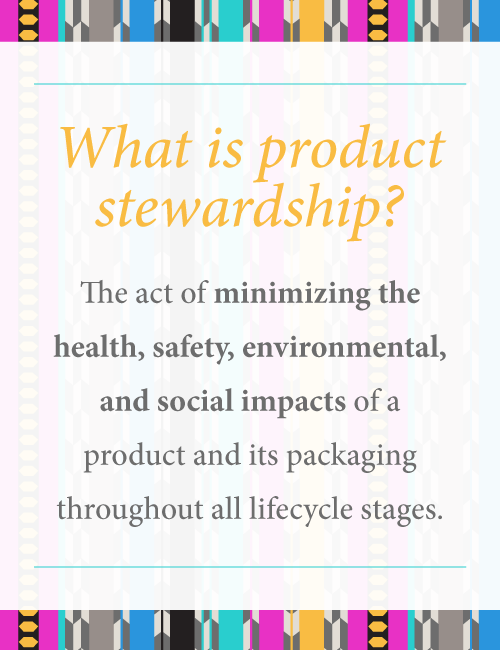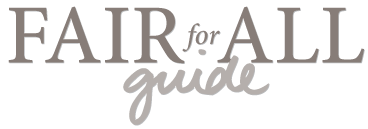Warning: It’s about to get a little technical up in here, but stick with me, it’s worth it.
Product stewardship is a concept I only recently became familiar with, but it kind of blew my mind. In a nutshell, this concept aims to address the question of who is responsible for the impacts of a product throughout its life cycle. According to the Product Stewardship Institute (PSI):
Product stewardship is the act of minimizing the health, safety, environmental, and social impacts of a product and its packaging throughout all lifecycle stages, while also maximizing economic benefits. The manufacturer, or producer, of the product has the greatest ability to minimize adverse impacts, but other stakeholders, such as suppliers, retailers, and consumers, also play a role. Stewardship can be either voluntary or required by law.
Basically, product stewardship puts the onus on manufacturers to take greater responsibility for the items they are putting out into the world. To me this feels like a radically different mindset from mainstream industry, but it makes a ton of sense. Consumers don’t have the capacity to sustainably handle the end-of-life of today’s increasingly complex products, and the public sector shouldn’t be responsible for cleaning up messes that can be avoided with more intelligent product design or end-of-life planning from the manufacturers. I agree with PSI that ultimately a team effort is needed, but I appreciate the emphasis on manufacturers not being able to wash their hands of the things they produce once they’re out the door.
In fact, PSI also defines a sub-concept specifically related to manufacturer responsibility:
Extended producer responsibility (EPR) is a mandatory type of product stewardship that includes, at a minimum, the requirement that the manufacturer’s responsibility for its product extends to post-consumer management of that product and its packaging. There are two related features of EPR policy: (1) shifting financial and management responsibility, with government oversight, upstream to the manufacturer and away from the public sector; and (2) providing incentives to manufacturers to incorporate environmental considerations into the design of their products and packaging.
Whereas product stewardship is a general philosophy, extended producer responsibility appears to be a policy-specific initiative with the goal of establishing EPR regulations for various industries.

The linear economy vs. the circular economy
The Product Stewardship Society frames the impact of product stewardship this way: “If the ‘linear economy’ is characterized by a ‘Take, Make, Use, Dispose’ philosophy, then the circular economy is an alternate concept, aimed at keeping products and their materials in play for longer periods of time.”
John Ortiz, a product stewardship manager at Hewlett-Packard, says the design of products in the circular economy may include “upgradeability, refurbishment, or empowering customers with service options.” This is a refreshing change from industry’s current focus on planned obsolescence and turning durable products into disposable ones.
Examples of product stewardship
End-of-life management is especially critical for products that can be hazardous when disposed of improperly. One example of product stewardship success is the paint industry, which has launched a take-back program in several states to safely handle the recycling and disposal of household paint. The pharmaceutical industry is currently under pressure to implement a more comprehensive drug take-back program to prevent the social and environmental hazards of unused or expired medications.
Various brands from Samsung to The North Face have implemented take-back programs with varying scopes/ease of access:
- Electronics Manufacturer Takeback Programs in the U.S.
- The North Face Clothes the Loop Program
- H&M Garment Collecting Initiative
- Patagonia Recycling Program
- Nike Reuse-A-Shoe Program
- Dispose My Meds Drug Takeback Directory
I feel like we’re at a revolutionary point similar to the stage in the Industrial Revolution when people began mobilizing for basic labor rights. We realized then that you can’t treat people as if they are disposable, and now we’re realizing that you ultimately can’t treat materials as if they are disposable either.
If the circular economy gains traction, it’s going to look totally different than today’s economy—imagine being able to repair products, pass them along to someone else in good condition, or turn them back in for safe disposal or reliable recycling. Instead of constantly chucking our goods to upgrade to the latest minor enhancement or trend, we can focus on enjoying the value that long-lasting products add to our lives. And for items that are truly consumable by nature, like paint or medication, we can dispose of them safely and confidently.
Do any of your favorite brands have take-back or recycling programs not listed above? Let me know about them in the comments!

Why You Should Know and Love Product Stewardship | Ecocult
[…] There’s so much more to learn; read it at Fair for All Guide! […]